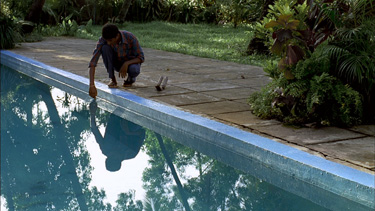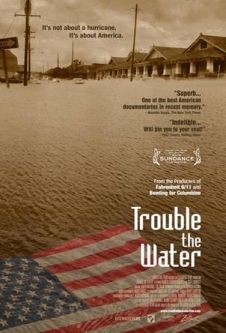Two Movies About Water
By Rob Christopher in Arts & Entertainment on Sep 23, 2008 5:05PM
This ain't the Dells. A pair of aquatic-themed films currently playing at the Landmark Century use water not only as a symbol but also as a character in their stories.
 Chris Smith is best known for his documentary American Movie, which traced the travails of making a low-budget horror movie in Wisconsin. His new film, The Pool takes place in Goa, India. Venkatesh is a young man who splits his time between working at a hotel and selling plastic bags on the street. He spends his free time sitting in a tree and looking longingly into a rich man's backyard, where a quiet pool sits. No one ever swims in it. Eventually he bluffs his way into a job as the man's gardener, also coming into contact with his sullen teenaged daughter, and finds that there are reasons why the pool remains unused. The movie unfolds just like a good book, moving the plot ahead while languidly chronicling the details of local life. There's a beautiful scene where the man doggedly hacks away at a freshly-picked coconut with a small machete. When it's been dehulled he scores the middle and breaks it in half, carefully preserving the milk inside. He gives one half to Venkatesh and they both drink. It's that eye for detail that draws us in and makes the characters and their world completely tangible.
Chris Smith is best known for his documentary American Movie, which traced the travails of making a low-budget horror movie in Wisconsin. His new film, The Pool takes place in Goa, India. Venkatesh is a young man who splits his time between working at a hotel and selling plastic bags on the street. He spends his free time sitting in a tree and looking longingly into a rich man's backyard, where a quiet pool sits. No one ever swims in it. Eventually he bluffs his way into a job as the man's gardener, also coming into contact with his sullen teenaged daughter, and finds that there are reasons why the pool remains unused. The movie unfolds just like a good book, moving the plot ahead while languidly chronicling the details of local life. There's a beautiful scene where the man doggedly hacks away at a freshly-picked coconut with a small machete. When it's been dehulled he scores the middle and breaks it in half, carefully preserving the milk inside. He gives one half to Venkatesh and they both drink. It's that eye for detail that draws us in and makes the characters and their world completely tangible.
 Trouble the Water, a documentary about the effects of Hurricane Katrina, has that tangibility built-in. It's to the movie's credit that it's able to take such a pervasive event and make us feel the horror and bewilderment of the storm anew. This is in no small part due to the remarkable footage of New Orleans resident Kim Roberts. The week before Katrina, she bought a camcorder off the street for $20 and began to record moments of daily life in the Lower Ninth Ward. When the storm hit and power was cut, she kept filming until the battery ran out, documenting how she, her husband Scott and their neighbors fought for survival: relocating to an attic, punching holes in the roof, and using a boat and even a surfboard that happened to be floating by as means of escape. Filmmakers Tia Lessen and Carl Deal have interwoven Kim's footage with clips of news coverage, and the contrast between the pontification of the TV slickers and the life-or-death struggle of the refugees is fascinating. The documentary certainly doesn't ignore the big picture, or the myriad failures that made for misery during Katrina. But, by and large, it chooses to show the event through the eyes of Kim and Scott, highlighting their courage and tenacity. As Christy LeMaster writes, "Only in a world where the documentarians have yielded to the messiness of the catastrophe around them and thrown objectivity to the storm is an astonishing movie like this possible."
Trouble the Water, a documentary about the effects of Hurricane Katrina, has that tangibility built-in. It's to the movie's credit that it's able to take such a pervasive event and make us feel the horror and bewilderment of the storm anew. This is in no small part due to the remarkable footage of New Orleans resident Kim Roberts. The week before Katrina, she bought a camcorder off the street for $20 and began to record moments of daily life in the Lower Ninth Ward. When the storm hit and power was cut, she kept filming until the battery ran out, documenting how she, her husband Scott and their neighbors fought for survival: relocating to an attic, punching holes in the roof, and using a boat and even a surfboard that happened to be floating by as means of escape. Filmmakers Tia Lessen and Carl Deal have interwoven Kim's footage with clips of news coverage, and the contrast between the pontification of the TV slickers and the life-or-death struggle of the refugees is fascinating. The documentary certainly doesn't ignore the big picture, or the myriad failures that made for misery during Katrina. But, by and large, it chooses to show the event through the eyes of Kim and Scott, highlighting their courage and tenacity. As Christy LeMaster writes, "Only in a world where the documentarians have yielded to the messiness of the catastrophe around them and thrown objectivity to the storm is an astonishing movie like this possible."